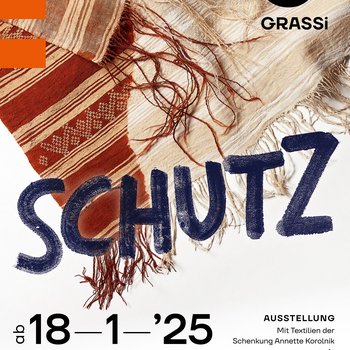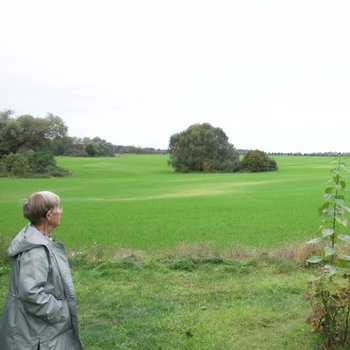I stood in the 'prep room' of the Grassi Museum in Leipzig in the spring of 2023. What I saw there, what I experienced and what followed me was unexpected. Inconspicuous at first glance. A cloth woven from sand-coloured threads, a few light stripes, and letters and drawings in brown. Or was I mistaken? None of this meant anything to me. But it wasn't meaningless. I wanted to touch the fabric. Something kept me. What was it?
Sometimes, when we stand on high mountains or look down from a tower, what we see appears symbolic. The world in front of us turns into shapes. We believe we recognize geometric figures and are tempted to decipher them, as if what we see can be read. What was just a house, a field, a tree, is suddenly signs, suddenly it is writing, undoubtedly. But we can't read them. We no longer understand what we just took for granted, it has become a riddle. The meaning, familiar and firmly grasped by a term, slips away from us. The desire for a new interpretation is awakened, but we remain perplexed by the strangeness of this hatching. A book title comes to mind: Die Lesbarkeit der Welt (The Readability of the World). Hans Blumenberg wrote it. The title is beautiful, and the idea is beautiful.
Title and thought returned before the cloth. They promised help in recognizing the blanket's own character in the symbolism that was - or seemed to be - inscribed in it. A direction was shown, seductive to follow. The temptation to touch the fabric grew with every glance. It almost seemed that if my fingers only stroked it first, the cloth would gain a voice and make itself known. From this voice, the story, reaching far back into time, would resound as a narrative, the distant past would return to the present, to my present. It was about people whose powerlessness was as great as the powers from which nothing and no one protected them - only this cloth. Where it came from, North Africa, it was called haik. Its power was hidden, there was no doubt about that. But where?
1 Siebente Sure. Der Wall. Geoffenbart zu Mekka. Cited from: Der Koran. Originally in Arabic. Translated by Max Henning. Leipzig: Reclam 1979, p. 175.
2 This is stated in a record (Arabic hadith) of sayings and actions of the Prophet Muhammad (probably written by Abū Hurairas). In: Saḥīḥ des Buḫārī,
Volume 3, Book 50, No. 894 (inter alia: Die Sammlung der Hadithe Sahih Al-Buhari. Leipzig: Reclam 2010).
3 Günter Eich: Allah hat hundert Namen. Ein Hörspiel. MCMLVIII. Insel-Verlag. Wiesbaden 1958, p. 7.
He identifies the voice as that of a prophet and does as he is told. He finds that Hakim in the Egyptian embassy as a janitor, who tells him his adventurous life story in a somewhat grumpy, almost unfriendly manner, triggered by that same prophetic voice. It seems to be playing hilarious jokes on him and, with the most bizarre instructions, mixes luck and misfortune so ludicrously that they can hardly be distinguished: Death and life shoulder to shoulder, ascent and descent in one stroke of the pen. For a long time, there is no mention of Allah's most holy name, instead of sacred souls there are unholy everyday occurrences. Even more, the voice of the Prophet also rang out to Hakim's wife Fatima, and when things finally got too crazy for him - a fish trading business in Damascus - he changed his life. He began to read obsessively, and the prophet remained silent. But then:
The day Fatima bought the fiftieth truck, and the eighth plane was the same day I realized where I had to direct my thoughts and aspirations: to the hundredth name of Allah. In it lies the secret of the world. But no matter how much I read, it was not written anywhere. [...]4
4 Günter Eich: Allah hat hundert Namen (like annotation 3)
5 Günter Eich: Allah hat hundert Namen (like ant. 3), p. 37.
6 Der Koran (like ant. 1), p. 156.
7 Günter Eich: Allah hat hundert Namen, p. 54.
8 ibid. p. 58.
9 ibid. pp. 60.
10 See also Ignaz Goldziher: Über Zahlenaberglauben im Islam. In: Globus 80 (1901), p. 31-32 (Reprint: Ignaz Goldziher: Gesammelte Schriften. Vol. 4. Published by Joseph de Somogyi. Hildesheim: Olms 1970, p. 261-262).
11 See also Edition ewige Weisheit. Über die innere Philosophie der west-östlichen Traditionen. https://www.ewigeweisheit.de [11 September 2023].
12 See also islam.de/73.php [11 September 2023].
It always starts with hearing voices, I think. No one is behind me, I don't check, why should I? The ghostly thing has no form, its reality is inconspicuous, as inconspicuous as the sand-coloured cloth in front of me. The signs in it are real, they have created a reality, the reality of the protective, the protecting. Their work alone testifies to the spirit in which those who have woven Allah's ninety-nine names into this Haik have trusted. Ninety-nine times hope for the last, the only, the signless. To be experienced as protection alone, nameless.
Keep Reading:
What is to be protected is regulated by law in the state system. One person who knows this particularly well is professor and lawyer Edi Class, who explains in his text how law and protection are related to each other.

A subway shirt is a wide piece of clothing, which one puts on to protect from prying eyes that, which will only be revealed at the end of the subway journey as the outfit for the evening. In this way it serves to protect those who wear it from abuse or any sort of molestation. Author Anna Katharina Hahn delivers a rarely heard perspective on the phenomenon of the subway shirt: that of the subway shirt.

Der etwa 20-minütige Film „Ein weites Feld. Grüne Rückzugsorte ostdeutscher Künstlerinnen“ von Susanne Altmann entstand 2023 in vier ostdeutschen Gärten und zeigt, wie Systemverweigerung auch aussehen konnte. Vier Künstlerinnen schufen sich jeweils ländliche Refugien, in denen sie inspiriert und unbeobachtet arbeiten konnten und eigene Netzwerke knüpften. Mit Erika Stürmer-Alex, Amrei Bauer für Annemirl Bauer, Christa Jeitner und Christine Schlegel.
